Dave Potts
Invasives Team Volunteer – Highbanks
Why I volunteer at Metro Parks, what I do and what I love most about it
I retired in 2016 after a full career working first in retail sales and then in real estate. I have lived in and around Columbus my whole life and I knew the Metro Parks very well. After a year or two of retirement I felt a strong urge to begin doing volunteer work. Volunteering at Metro Parks held the strongest appeal for me. And getting rid of invasive species in the parks felt like a very good way to give back to my community.
I joined the Metro Parks volunteer program in spring 2019. At my orientation session, I told the organizers that I was keen to remove invasive plants, and they told me they would set up a training session. There was already an invasives removal volunteer team working out of Highbanks, and I joined this crew. It hadn’t been going for very long, so I was in almost from the beginning.
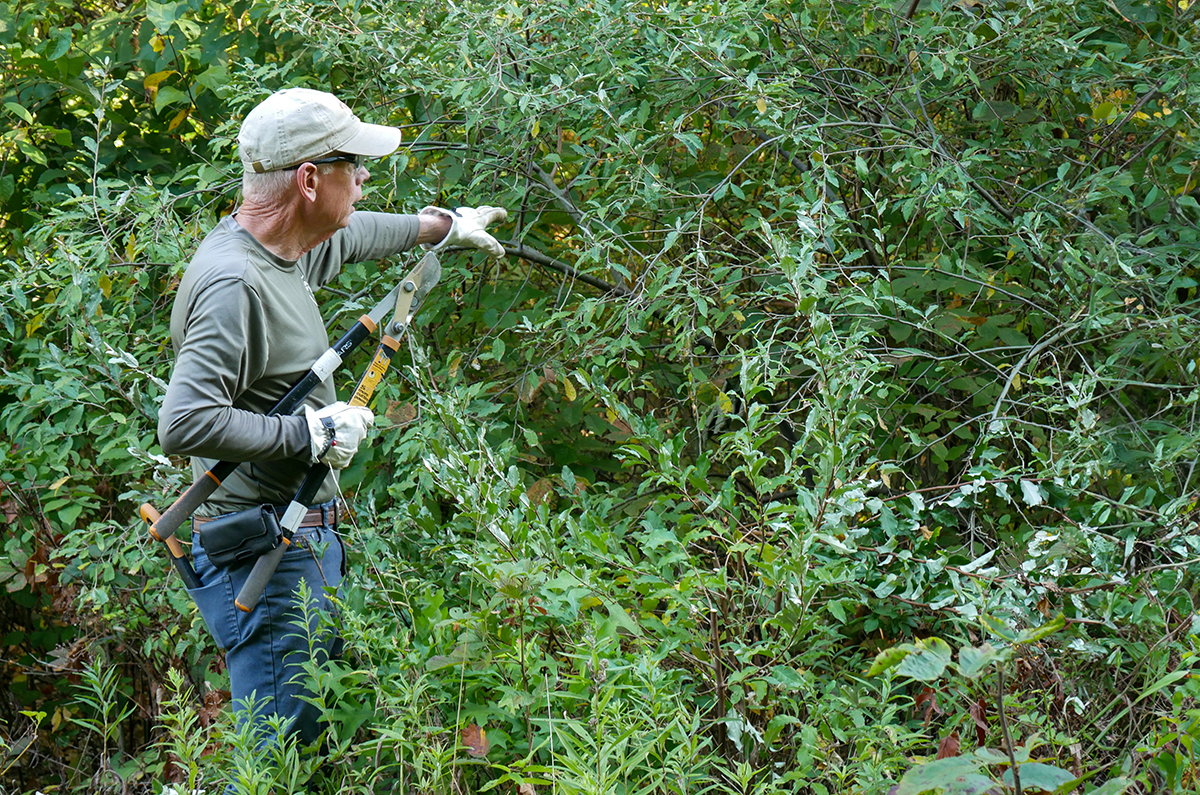
The Invasive Team works at Highbanks every Tuesday and Friday morning. We don’t work in heavy rain, nor if temperatures exceed 85 degrees, nor if temperatures fall below freezing, but aside from that we work from 9am until noon on those two days of the week right throughout the year, spring, summer, autumn and winter. We get great support from the Highbanks Park Manager, Matt, his assistant Alan, and park naturalists Chrissy and Claire. If we ever need anything, we know we can rely on them to help.
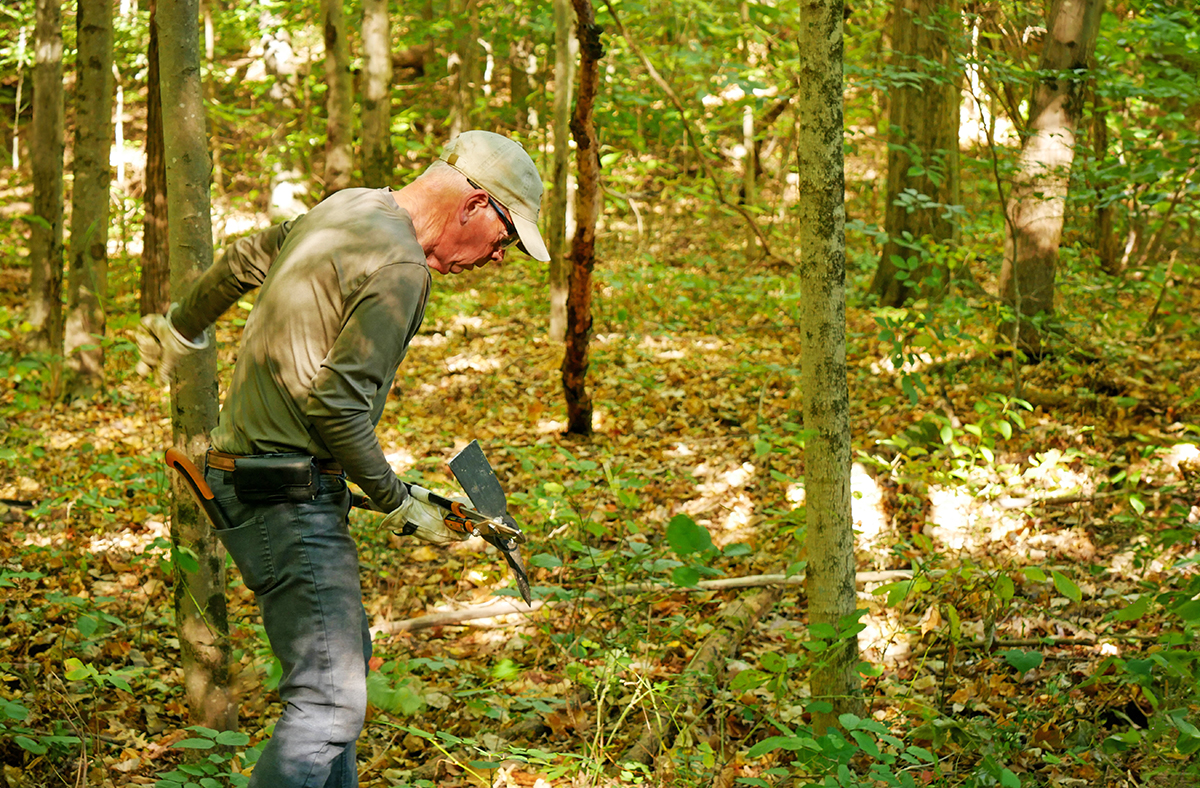
We have a core group of eight people on the team, and most of us are retired. Along with myself, the core group includes Tom, Greg, Bob, Curt, Ann, Lynn and Jim. Other team members (Margot, Taylor, Diana, Susan, Jane, Rick and Howy) come when they can. One of our founder members, Tom, does the mapping for us, producing maps that show which areas of the park we’ve cleared so far and which areas we’ll be tackling in the months ahead. I usually send out weekly emails to our full team, letting everyone know where we’ll be working in the week ahead. We usually get between five and eight members at each of our twice-weekly sessions. We hold an annual Pot Luck for the full Invasives Team each November, and discuss the year ahead and new areas we might be working in. In our few years of operation, we have cleared about 300 acres of the park of damaging invasive plants.
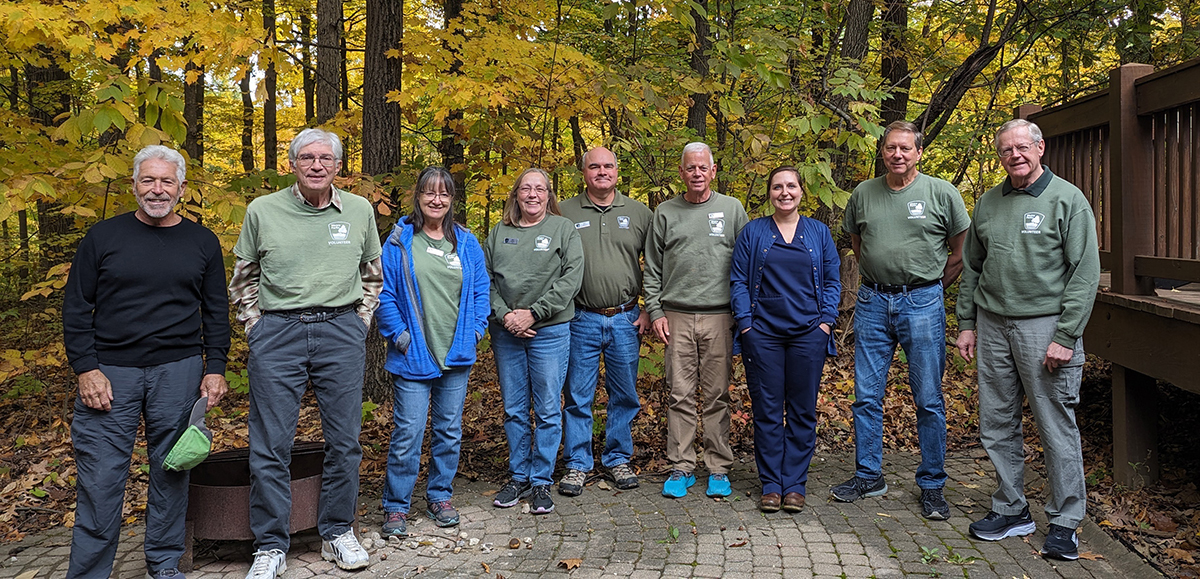
One of the most damaging of all the plants is the amur honeysuckle, which is rampant across the entire state of Ohio. It’s a native of northeast Asia and was introduced in southern Ohio in the 1950s. It tolerates both sun and shade and grows incredibly quickly, out-competing native plants for moisture and nutrients in soil. Other out-of-control invasives that we seek to eliminate include privets, burning bush, multiflora rose, Asian bittersweet, autumn olive, garlic mustard, and dame’s rocket.
When we work in a new area, which we call our first sweep, we go in with our heaviest equipment, all of it hand-held, including uprooters and loppers. We aren’t allowed to use power tools, and we don’t use herbicides. These first sweeps can take us up to two or three months to eradicate the invasives in the area. We cut down the invasive plants and form huge piles of cuttings, which can spread out and reach up to 10-feet high. We call these large piles “habitat huts,” as many small animals use them to hide from predators or even to find nesting sites. These piles will eventually decompose and reduce in size. We return to these “first sweep” sites one or two years later and pull up any remaining invasives by the roots. Many of the tall invasive plants grow alongside our park trails and form a barrier to the adjacent woods. So we call these follow-up sweeps our “Walk in the Woods” sessions, as we can now see into the woods, and we are always gratified to note that native plants are beginning to reestablish their presence there.
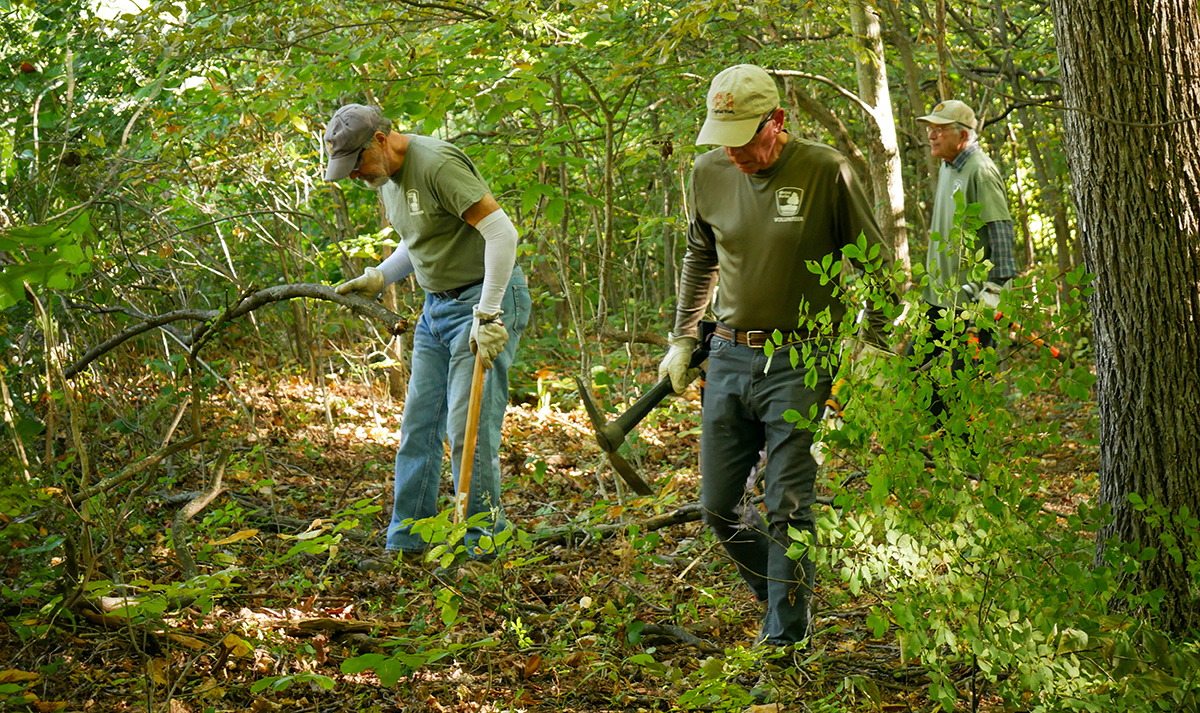
As the team develops and gains experience of the work, we all manage to increase our knowledge and ability to recognize which plants are invasive and which plants are native. All of us derive great satisfaction from helping the environment and making the park a better place through our volunteer efforts. When I walk the trails later and see those avenues into the woods that were previously blocked off by the honeysuckle and other invasives, I get a sense of instant gratification. It’s hard work, on the invasives team, but so rewarding.
In a typical year, I give about 300 hours of volunteer service at Highbanks. That is mostly on the Invasives Team, but I also like to do an occasional “trail rove,” which is where a volunteer goes roving the park trails to greet visitors, talk about the parks, and sometimes to arrange an impromptu trash pickup. I also volunteer occasionally on public programs led by a park naturalist, where I can often learn new things, and also contribute some of my own knowledge. Many of my favorite such programs include wildflower or tree identifications, and I’ve really enjoyed volunteering at a couple of edible plant programs.
A little more about me
I graduated from Columbus North High School in Clintonville. I lived in Clintonville with my parents, my sister and three brothers in a crowded house but a very happy home. My sister Carol was the eldest of my siblings. My brother Mike was older than me and Steve and Chuck were younger. I lived in Clintonville till I was 18 and now live in Dublin with my wife of 43 years, Theresa. I went to Ohio State and took biology and English courses, but I could never quite decide what I wanted to do career wise. After nearly three years at OSU I left without graduating, as I still couldn’t narrow down what I wanted to do work wise. This was in 1972. My first jobs were in retail sales, but I found my true career calling somewhat later. I was working for a building firm, and selling new houses for them. I enjoyed this, but after a good 14 years of that, I decided to change tack and I qualified as a licensed real estate agent. I worked for the Pickerington branch of Re/Max for many years, and later for a smaller, independent real estate agency.
I did a lot of walking in the Metro Parks and would frequently see these great green walls of honeysuckle. I didn’t know they were invasive plants, and didn’t know how they crowded out and effectively killed our native plants. I first learned about invasives by taking some Metro Parks public programs, and I read a lot more about invasive and non-native plants and their negative impact on our environment after that.
My favorite Metro Parks activity
I just turned 74, so it’s important to me to keep fit, especially with all the hard work needed to eliminate all those invasive plants. I use my phone to monitor my steps, and aim for 12,000 steps a day. For my stride length, that equates to something like 4.5 to 5 miles a day. Quite often, I’ll walk in my neighborhood, but as I live in Dublin I also walk frequently at my nearest Metro Park, Glacier Ridge. Most of the trails at Glacier Ridge are paved and in the open, so I prefer going to Highbanks for longer hikes, as there are more trails with natural surfaces. These are easier on the joints. And these trails mostly go through the woods, which I enjoy. I like to walk the Dripping Rock Trail and the Overlook Trail together in one session, which comes to just under 5 miles. My favorite Metro Park to hike in is Clear Creek, and I love the ruggedness of their trails and all the elevation changes. Because it’s such a long drive to get there, I don’t manage to get to Clear Creek too often, but when I do I usually walk at least 8 miles.
A good few years ago I often went to Blacklick Woods with a friend of mine, and we would select a couple of trails and see how quickly we could walk them. These days, I am no longer interested in walking the trails quickly. Ever since my interest in trees and plants developed, I like to take my time and I often stop to look at the plants. I have an app on my phone, called SEEK, which I use to identify any plants that I’m unfamiliar with.
I like to ride my bike on Wednesdays and Thursdays, and I also go to a gym once a week. For the past few years I’ve also adopted a plant-based diet. It isn’t quite a vegan diet, and I sometimes deliberately abandon the diet as a one-off treat, especially if cake is involved. Cake may be made with eggs and butter, which I typically avoid, but cake is cake, and I love it. So if I’m ever invited to a birthday party, I know that cake is in my immediate future.
I’ve become quite interested in foraging, more as a theoretical rather than a practical exercise, but I like to identify what plants are edible. Foraging is not allowed in Metro Parks, but you’d be surprised just how many edible plants grow wild in your neighborhoods. One of the invasive plants that we strive to eradicate at Highbanks, the autumn olive, has berries that make a delicious “fruit leather.” I’ve collected these berries in my neighborhood and have actually made this wild and delicious treat. First of all, I boil the berries in a pan of water, so I can more easily remove the skin and the seeds. Then I let the berries dehydrate until they become very dry and leathery. That’s when they’re ready to eat. They are both sweet and tart, and they’re very healthy. Much more healthy than anything you would find wrapped in cellophane at a grocery story.
Knowledge like this, and working on clearing the invasive plants at Highbanks, has made me feel a lot more connected with nature. And that’s what I love most about our wonderful Metro Parks, being in nature.
Another park activity that is in my imminent future is a walk on the via ferrata at Quarry Trails Metro Park. I’m actually somewhat scared of heights, so this iron path trek along the quarry cliff walls wouldn’t be something that I’d normally seek out for myself. But one of my daughters, Jennifer, has done the via ferrata twice now, and she really wants me to go with her the next time.
My favorite Metro Parks story that includes a positive or memorable visitor interaction
Being in the park with the Invasives Team every Tuesday and Friday means we often encounter regular park visitors. They see our Metro Parks volunteer shirts and often ask about what we’re doing, or just thank us for our hard work in making the park environment healthier for our native plants and animals. We get a lot of that and it always means a great deal to us all, to be recognized and appreciated for what we do as volunteers. I remember a particular encounter on the Dripping Rock Trail earlier this year that I found memorably satisfying. A mom and dad stopped by to say hello, and they had their 7-year-old son with him. The boy was especially interested in what we were doing and they stayed talking with us for a good 10 minutes or more. The boy was enthralled when I showed him how to smell the spice of a spicebush tree. You just need to scrape your finger gently across the bark and you can smell the delicious spice. He was especially delighted when I told him that the spicebush is a native tree, and wasn’t amongst the invasive plants we were eradicating.
Traveling – places I’ve been, places I’d love to go
My daughter Jennifer used to live in Belgium, when her husband was serving overseas with the US forces. On a visit to see her, we got to enjoy a short European tour. We went to Brussels and Paris, but the best part of our trip was a visit to Germany, to a town called Bernkastel. It’s on the Moselle River, in Germany’s wine growing region. It was a quaint old town with lots of mediaeval buildings and the food was great. This was before I adopted my plant-based diet, so I enjoyed their various sausage and meat dishes, such as their delicious bratwurst and sauerkraut. The German beer was good too. We also visited Ireland on that trip, and saw the Cliffs of Moher, which are known for their wide-ranging flora and fauna. It’s also the closest point anywhere in Europe to North America.
As a family, we’ve also visited a lot of our National Parks. Ohio has a lot to offer, but we don’t have mountains, and we don’t have deserts, so those are features I love to see on vacation. We’ve been to Acadia National Park in Maine, Capital Reef in Utah, Indiana Dunes, and Sleeping Bear Dunes in Michigan. Other national parks we’d love to visit in the future include Big Bend National Park in Texas, and Glacier National Park in Montana.
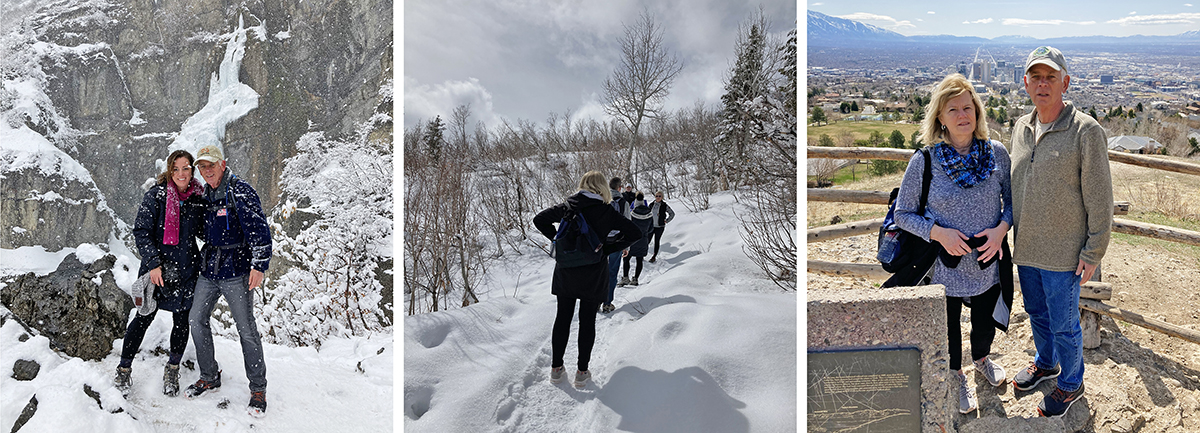
Fun facts about me and my family
1. Three daughters, nine grandchildren! My wife Theresa and I have three daughters. They all live close by to us. Natalie, our middle daughter, also lives in Dublin and is only a couple of blocks away from us. Our youngest daughter, Jennifer, lives in Powell, and is only 20 minutes away from us. And our eldest daughter, Renee, lives in Delaware, and is only 25 minutes away. Renee has two boys, Natalie has three girls and one boy, and Jennifer has two boys and a girl. We all get to see each other frequently, which is great.

2. Family vacations! It was about nine or 10 years ago that we all headed out to Traverse City in Michigan for a complete family get-together vacation. It was on that vacation that we visited the Sleeping Bear Dunes National Park, which is about 20 miles from Traverse City. The dunes were very high, some of them rising as much as 300 feet above their base. I remember treking out onto the dunes and losing everyone else as I pressed on, going up, down, up, down as the succession of massive dunes ran on for miles. Just last year, we enjoyed a somewhat less challenging vacation when we all got together again to visit Norris Lake in Tennessee. We hired a pontoon boat to explore the lake, which isn’t very wide but it is very long. It stretches for about 800 miles and was formed in the mid-1930s by the creation of the Norris Dam. It was a wonderful holiday for boating and swimming. We brought our jet skiis and had a great time organizing family races.
3. The Lion King! Earlier this year, as a special family treat, all of us got together to go to a Broadway Theater production of The Lion King. There were 17 of us, all told, and we started off the evening by dining at the exquisite Milestone 229, a restaurant with wonderful scratch menus and fantastic views of the Scioto River and Scioto Mile. Then it was on to the theatre for a great evening. The music and acting was terrific, and the costumes were extraordinary. We all loved every minute of it.
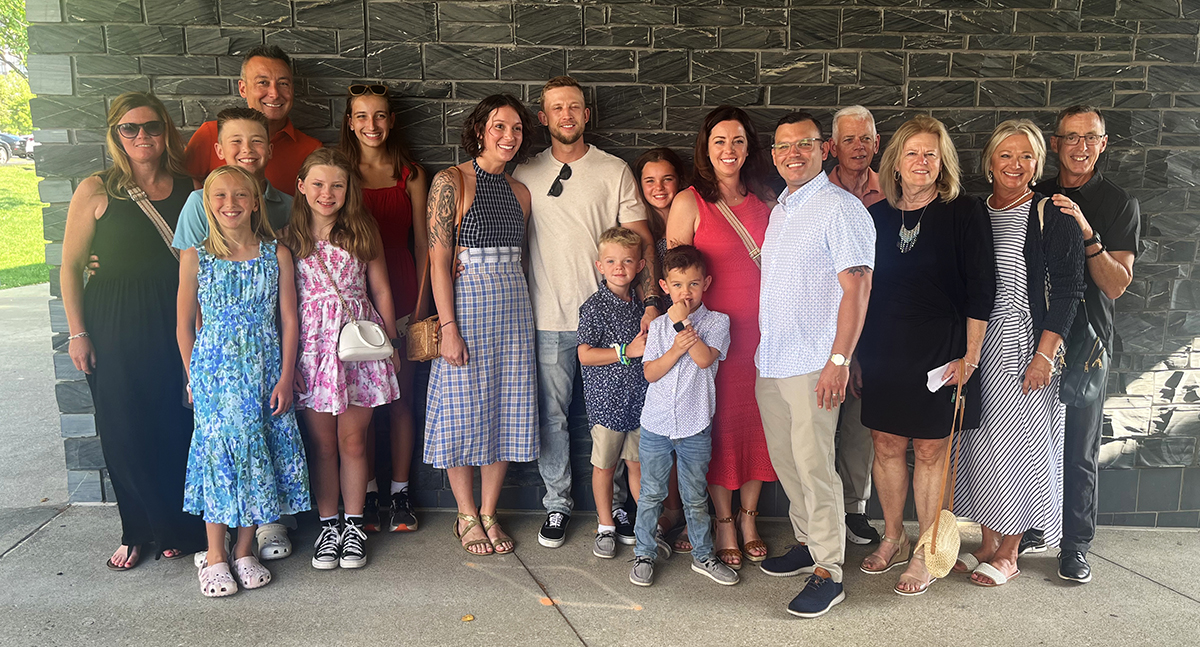
My favorite food and dessert
I’m on a near-enough vegan diet these days, although I prefer to refer to it as a plant-based diet. In older days, before I cried off meat, I really enjoyed pork spare ribs or a really good burger, and pepperoni was a favorite pizza. These days, I really enjoy cooking my own plant-based burgers, using black beans, mushrooms, onions, red peppers and a few spices. I bake them in the oven, which keeps the beans firm. They can get too soft or mushy cooked in other ways. I do a lot of cooking at home. I like making soups, especially one that I call my cosy autumn soup, plus spicy dishes like vegetable chili and a meatless jambalaya. My wife and daughters aren’t committed to my diet, but they do enjoy some of my dishes.
For desserts, I’ve already mentioned my almost drug-dependent predilection for cake. I make my own healthy alternative, a vegan banana bread that seems to be enjoyed by all the family. My grandkids prefer a version with chocolate chips added to it, so I sacrifice a few principles for their enjoyment. When I make it for myself, I usually add walnuts.
My favorite entertainment
I really enjoy reading. Of late, I’ve been reading a number of books about stoicism. I’m not really a stoic myself, but I like the way stoics view life and death, which they’re not afraid of. Currently, I’m reading How to Think Like a Roman Emperor: The Stoic Philosophy of Marcus Aurelius. It’s a book by Donald J Robertson and shows how some of this ancient emperor’s self-help philosophy can be applied to our own lives today and help to strengthen us emotionally as we cope with life’s many challenges. You might say I’m an amateur stoic. I’ve learned a lot from reading about stoicism that helps me in my daily life, which is a very calming philosophy and teaches us to recognize that some things are simply beyond our control. It’s about ‘letting go’ and that’s a very valuable lesson. I also enjoy humorous books. Some favorites are Bill Bryson’s A Walk in the Woods and Fredrik Backman’s A Man Called Ove.
I don’t watch much TV but I really enjoy listening to music, especially jazz. My favorite jazz performers are Trombone Shorty and Miles Davis.
Dave Potts was talking to Communications Coordinator, Virginia Gordon
What Highbanks Naturalist Claire Whillans says about Dave
“Dave is one of our most dedicated and passionate volunteers. He has personally contributed over 1,000 hours of invasive species removal here at Highbanks over the past five years. Dave’s work, along with the rest of the invasive team, has made a significant and noticeable contribution to the beauty of our trails and restoration of natural habitats throughout the park. His soft spoken and kindly manner, combined with his extensive knowledge of edible plants, always makes for an interesting and enjoyable conversation. We are extremely lucky to have Dave here at Highbanks!”

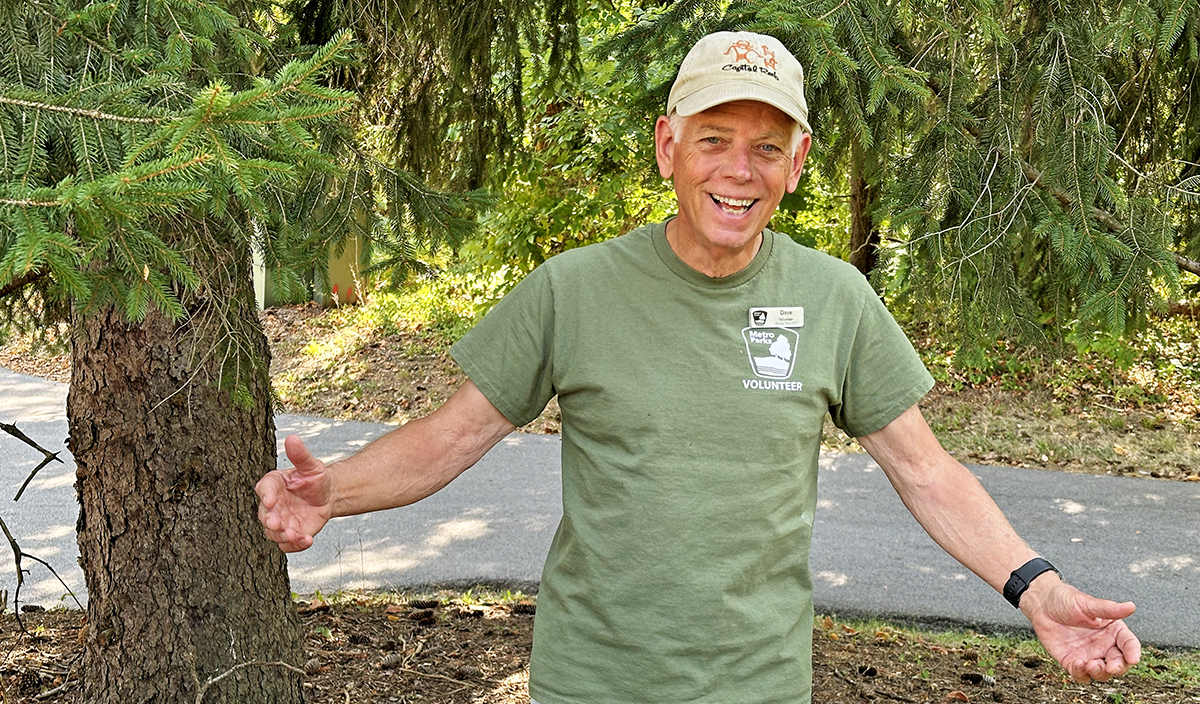
I am a regular hiker at Chestnut Ridge Metropark which has a significant invasive species problem. I would be open to joining an invasive removal project here. Great job Dave!
Hi Max – thank you for commenting, and for your interest in volunteering. For volunteering, you can sign-up from our volunteering page, https://www.metroparks.net/programs-and-activities/volunteers/, and seek out the best volunteering options for you. Best of luck.
What a cool guy! 🙂
Thank you Dave for all you, and the others on your team, do to maintain the beauty and health of the plants at Highbanks. I was raised there in the late 1040’/early 1950’s, my parents sold the “farm” when they got divorced and donated part of it to the State to be used as a park. I visted again a few years ago and helped some of the staff identify pictures of our old house, called the Mansion now. Most of what I knew when I lived there is now gone-the ice house, 6 car garage, large gardens, our house, etc. However it makes my heart happy to see that the property is being maintained and used for everyone to enjoy. Lyn Mumma Sherman
Thanks for all your hard work at Highbanks, Dave! We love our Metroparks, especially Highbanks.
Very interested to hear of Dave’s work on invasive plants. Keep up the great work!